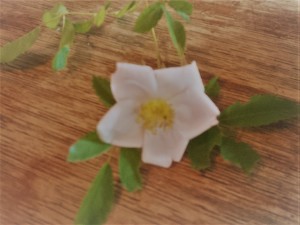For some people, the word “vacation” means trips to the beach and hours spent wallowing in trashy novels. Others wouldn’t go near a beach or a trashy novel, but love to tramp around historical sites, museums or battlefields. It all depends on your definition of another important word— “relaxation”.
My husband and I used to relax by looking for roses, specifically the old or species roses that sometimes grow in untended cemeteries. This may sound a little morbid, but it isn’t. Previous generations of Americans sometimes planted a favorite rose or other plant on the grave of a departed loved one. Over time, these plants either survived and thrived or died out due to a combination of harsh weather and neglect. Finding a survivor rose is akin to finding buried treasure.
Identifying that survivor is an even greater coup.
We started rose hunting because of a book—In Search of Lost Roses by Thomas Christopher. I read it and enthused so much about it that my husband ‘s interest was finally piqued. Afterwards, whenever we were out in the country, we would search out old cemeteries to see if we could find roses. Sadly, survivor roses planted in the northeastern cemeteries we frequented were few and far between. The plants we encountered most often were myrtle or Vinca minor and poison ivy. Identifying them was no problem.
I haven’t done any rose hunting since my husband died, but the other day a rose found me. I was walking on a country road near our family’s summer cottage in central New York State when I caught sight of a flower growing in the right-of-way at the edge of a hedgerow beside the highway. It was a rose—about two inches wide, with five pale pink petals surrounding a central boss of golden stamens. A closer look revealed that it was part of a sprawling shrub that meandered through the abundant early summer underbrush. The remains of other blooms clung to the stems and a few pink buds suggested that more flowers were in the offing.
Positioning myself somewhat precariously over the deep ditch that separated the road shoulder from the hedgerow, I pulled out my cellphone and took as many pictures as I could of the flower, stems, prickles and leaves.
The flower’s shape and petal count suggested a wild or species rose. A number of wild roses are native to North America and the research I did when I returned to the cottage suggested five possible species, all of which bear light to medium pink blooms.
My rose had foliage that botanists describe as “pinnately compound”, which means that each “leaf” is actually a cluster of odd-numbered leaflets. Most of the leaflet clusters on my rose bore five medium green leaflets. This seemed to rule out one species, Rosa woodsia, which most commonly sprouts pinnately compound leaves with three to nine blue-green leaflets.
That left four more possibilities.
I looked at the prickles on my rose, which were somewhat hook-shaped and mostly paired on the stems. This prickle arrangement was at odds with descriptions of two other species native to my area, Rosa carolina and Rosa nitida. Carolina roses feature “straight, needle-like thorns” and nitida roses bear stems that are covered in bristles.
Only two natives remained, and they appeared almost identical in the pictures I saw online.
The odds were in favor of Rosa virginiana, which is the most common wild rose in this part of the country. However, Rosa palustris, aka “the swamp rose” was also a serious contender. Not surprisingly, swamp roses occur in wet or frequently wet spaces. My rose was growing adjacent to a ditch that fills with water whenever it rains hard. Clearly “wet feet” were no obstacle for this particular plant.
In the end, identification came down to the stipules, plant parts that are generally of interest only to botanists. These growths are, according to the Connecticut Botanical Society, “small, leaf-like appendages at the base of a leaf stalk.”
I looked at the stipules on my rose plant. They were not exactly enormous, but were clearly fatter than the narrow leaf stipules of Rosa palustris. My rose was almost certainly the Virginia rose, not the swamp rose.
Of course, most of us fall victim to “Antiques Roadshow” syndrome and live in the hopes of finding rare and valuable antiques in forgotten corners of the attic, garage or cellar. Plant lovers feel the same way about finding unusual plants. I was happy about making a positive identification of my wild rose, but I would have been even happier had it been the more unusual Rosa carolina or even the second runner-up, swamp rose.
Still, my rose discovery revived my interest in rose hunting. Now I am consulting old maps to find rural cemeteries. Who knows, maybe the next cemetery will hold a rose that has been lost to commerce for the past century. I will get out the poison ivy remedy and prepare for the hunt.

